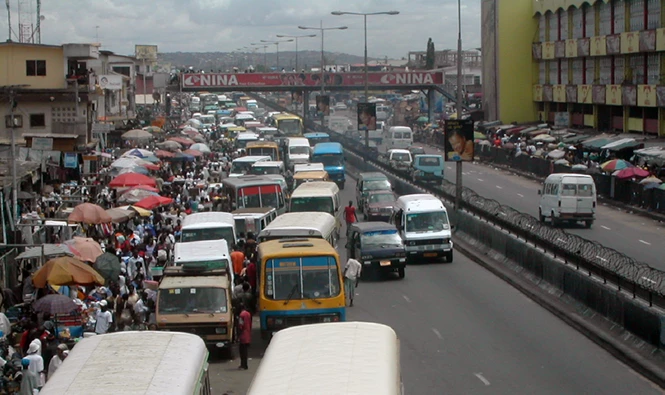
Indeed, motorization – the process of adopting and using motor vehicles as a core part of economic and daily life – is closely linked with other dimensions of development such as urbanization and industrialization.
Motorization, however, is a double-edged sword.
For many households, being able to afford their own vehicle is often perceived as the key to accessing more jobs, more services, more opportunities—not to mention a status symbol. Likewise, vehicles can unlock possibilities for firms and individual entrepreneurs such as the young man from Uganda pictured on the right, proudly showing off his brand new boda boda (motorcycle taxi).
But motorization also comes with a serious downside, in terms of challenges that many governments have difficulty managing. Motor vehicles can undermine the livability of cities by cluttering up roads and open spaces—the scene of chaos and gridlock in the picture below, from Accra, is a telling example. In addition, vehicles create significant safety hazards for occupants and bystanders alike… in many developing countries, road deaths have effectively reached epidemic proportions. From an environmental standpoint, motorized transport is, of course, a major contributor to urban air pollution and greenhouse gas emissions. Lastly, motorization contributes to countries' hard currency challenges by exacerbating their long-term demand for petroleum products.
Given these challenges, how are developing countries going to align their motorization trajectories with their development goals? What should the World Bank advise our clients about how to manage this process?
Recently, a multi-disciplinary team of specialists from the World Bank and partner organizations set out to build, pilot, and refine a methodology to guide our client countries on managing motorization. One of the key premises behind this work was that the motorization path of developed countries provided no clear guidance or model for the developing world. In OECD countries, where vehicle fleets tend to be cleaner and safer, quality improvements over time have primarily occurred through technological advances of new vehicles entering the fleet, fairly high rates of vehicles falling out of use, and relatively predictable adherence to vehicle maintenance regimes. In the developing world, by contrast, second-hand vehicle imports account for the vast majority of vehicle fleet growth. Different contexts call for different solutions, so our team had to develop a framework that would take into account the specific motorization pattern of developing countries.
We piloted the approach in Ethiopia and Kenya, using an interactive methodology anchored around three workshops involving key stakeholders—government officials, vehicle importers and operators, and representatives of the vehicle maintenance industry. The last of these workshops concluded in March.

- Enhancing vehicle safety, particularly to reduce the impact of a potential crash on occupants (crashworthiness)
- Lowering emissions
- Improving the fuel economy of both the private and commercial vehicle fleet as it grows
- Ensuring that the pace of motorization is in line with what the country is ready to absorb.
The reports from these pilots are still being finalized, but already there is active discussion on extending this work in the two pilot countries through further technical assistance and lending operations. In addition, several other countries have expressed interest in applying the methodology, including two outside Africa.
The World Bank has been actively working in recent years to change the way we approach transport with our client countries, shifting the focus from simply delivering infrastructure to a more holistic vision of providing sustainable mobility solutions for all. As we continue this effort, let’s hope our work on motorization management can emerge as a way of incorporating the vehicles themselves into the conversation.


Join the Conversation